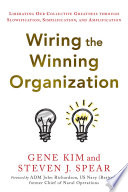

The concept of 'wiring' in an organization refers to the intricate network of relationships, processes, and systems that connect individuals and teams. This wiring is essential for fostering collaboration, innovation, and efficiency. Organizations that prioritize effective wiring can respond more swiftly to market changes, leverage collective intelligence, and create a culture of shared purpose. The book emphasizes that the wiring should not be seen as static but rather as a dynamic framework that evolves with the organization. Leaders must regularly assess and adjust this wiring to ensure it aligns with strategic goals and the changing landscape.
Continue readingA winning culture is foundational to the success of any organization. The book outlines the characteristics of a winning culture, including trust, transparency, and empowerment. Leaders play a crucial role in shaping this culture by modeling desired behaviors, encouraging open communication, and recognizing contributions. A strong culture not only enhances employee engagement but also drives performance and innovation. The authors argue that organizations with a winning culture are better equipped to attract and retain top talent, navigate challenges, and achieve long-term success.
Continue readingIn today's digital age, technology serves as a critical enabler of organizational wiring. The book discusses various tools and platforms that facilitate communication, collaboration, and information sharing. By leveraging technology effectively, organizations can break down silos, enhance teamwork, and improve decision-making processes. The authors highlight the importance of selecting the right tools that align with the organization's goals and culture, as well as training employees to utilize these tools effectively to maximize their impact.
Continue readingLeadership is a key driver in the wiring of an organization. The book emphasizes that effective leaders must understand the dynamics of their organization and actively work to foster connections among individuals and teams. This involves not only setting a clear vision and direction but also being approachable, supportive, and open to feedback. Leaders should also be intentional about building relationships and networks within the organization, as these connections are vital for collaboration and innovation. The authors provide practical strategies for leaders to enhance their wiring capabilities.
Continue readingThe ability to learn and adapt is crucial for organizations to thrive in a rapidly changing environment. The book advocates for a mindset of continuous learning, where organizations encourage experimentation, embrace failure as a learning opportunity, and seek feedback from all levels. This culture of learning fosters innovation and agility, enabling organizations to pivot quickly in response to new challenges and opportunities. The authors stress the importance of creating systems that support learning, such as mentorship programs, training initiatives, and knowledge-sharing platforms.
Continue readingTo ensure that the wiring of an organization is effective, it is essential to measure success and impact. The book discusses various metrics and KPIs that organizations can use to evaluate their performance in relation to their wiring efforts. This includes assessing employee engagement, collaboration effectiveness, and overall organizational health. The authors emphasize that measurement should be tied to the organization's strategic objectives and that regular reviews should be conducted to identify areas for improvement and celebrate successes.
Continue readingEngaging stakeholders—employees, customers, partners, and the community—is vital for the success of an organization. The book highlights the importance of building relationships and fostering a sense of belonging among all stakeholders. By actively involving stakeholders in decision-making processes and seeking their input, organizations can enhance their wiring and create a more inclusive environment. The authors argue that organizations that prioritize stakeholder engagement are more likely to achieve sustainable success and drive positive change.
Continue reading